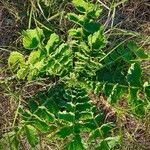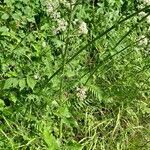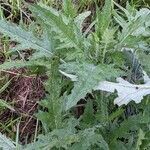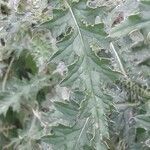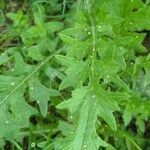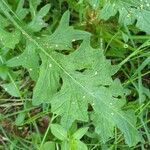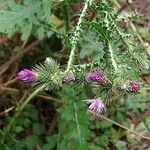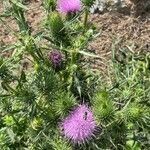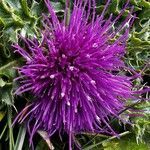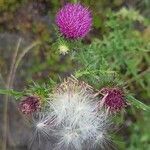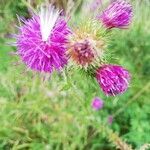Taprooted biennial. Stems branched above, 1-2 m tall, with usually sparse multicellular or cobwebby hairs, strongly ribbed; wing narrow or interrupted between the deltoid or palmatifid clusters of teeth; spines 5-10 mm long. Lvs narrow to oblong-lanceolate, deeply 1-2-pinnatifid, 5-20-(40) × 1.5-10-(18) cm, glabrous except for sparse multicellular cobwebby hairs on midrib; basal lvs with 5-9 pairs of lobes; lobes palmatifid-dentate; teeth spine-tipped; spines pale, 3-5-(8) mm long. Capitula erect, persistent, (1)-1.5-(2) × 1.5-2 cm, solitary and pedunculate or in sessile or subsessile clusters of 2-4; peduncle 1-1.5-(2) mm diam. Involucre globose, ovoid or hemispheric. Outer and middle involucral bracts linear-acuminate, evenly tapered to erecto-patent spinous tip, without distinct claw and limb, with sparse cobwebby hairs; midvein raised almost to base. Inner involucral bracts linear, puberulent; midvein barely raised in distal 1/2of bract; apex acute, scarious, often pink. Corolla red-purple, pinkish, or white, (12)-14-18 mm long; lobes 5-6 mm long; swelling at throat of tube oblong, > 2 mm long. Achenes pale, ellipsoid, 3-4 × 1.5-2 mm; pappus 11-14 mm long.
Biennial, 3–15 dm, very strongly spiny, the stem tough; lvs deeply lobed or pinnatifid, to 25 × 8 cm, loosely villous beneath, chiefly along the main veins, with long multicellular hairs, or glabrous, the upper surface glabrous or similarly hairy; heads clustered or solitary at the ends of the branches, erect, small, the invol 1.4–2 cm high, the disk 1.5–2.5 cm wide (pressed); peduncles, if any, winged all the way to the heads; invol bracts narrow, rarely as much as 2 mm wide, erect or loosely spreading, the middle and outer spine-tipped, the inner softer and flatter; 2n=22. Roadsides, pastures, and waste places; native of Europe, now widely but sparingly established in our range. July–Oct.
Herb to 1 m high. Stem sparsely pubescent; wings 1–4 mm wide. Leaves green, with multi-cellular hairs mainly along midrib and on major veins; glands absent; marginal spines 2–6 mm long, white to brownish. Capitula in sessile or shortly pedunculate clusters, terminal, erect; involucre hemispherical, 10–16 mm wide excluding patent bracts, somewhat deciduous at fruiting stage; median involucral bracts erect or recurved, narrowly deltate, 9–13 mm long, 0.8–1.5 mm wide at widest point, entire, sparsely arachnoid dorsally. Corolla tube 9–10 mm long; lobes 6–8 mm long. Anthers 5.5–6.5 mm long. Mature achenes not seen. Pappus bristles 11–14 mm long.
A herb. It is a thistle. It grows 20-100 cm tall. It can take 2 years to complete its life-cycle or keep growing from year to year. It has a single stem with long branches. The leaves are 6-29 cm long by 2-7 cm wide. They have lobes along the stalk with 6-12 pairs of segments. The flower head is at the top of the stem and 2 cm across.
